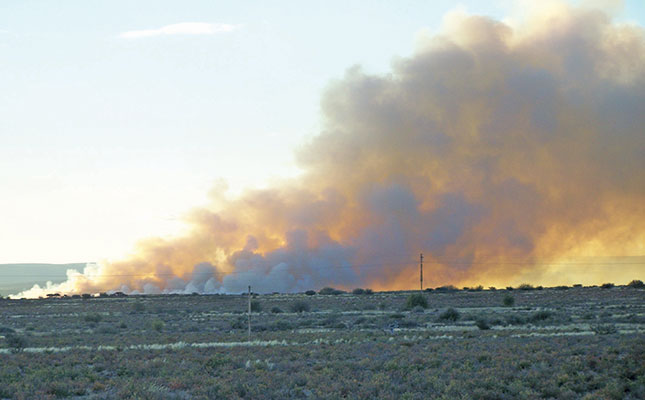
Photo: FW Archive
Tell us more about the Free State Umbrella Fire Protection Association.
The Free State Umbrella Fire Protection Association (FSUFPA) represents various fire protection associations (FPAs), the provincial disaster management centre and regionally represented landowner organisations that wish to become organised for the purpose of [implementing]the National Veld and Forest Fire Act (NVFFA) of 1998.
FSUFPA was formed in 2012 in terms of Section 4(9) of the NVFFA with the aim of supporting the sustainable implementation of integrated wildfire management practices on a local, regional and provincial level.
FSUFPA is the primary operational structure that provides support to its members and the provincial disaster management structures relating to integrated wildfire management in the province.
To this effect, FSUFPA is officially recognised as a Provincial Umbrella FPA by the Department of Forestry, Fisheries and the Environment and is mandated by the Provincial Disaster Management Centre to liaise, advise, inform, coordinate, capacitate and engage with all stakeholders pertaining to integrated wildfire management in the province.
Why are FPAs important?
The NVFFA makes landowners responsible for preventing and extinguishing veld, forest and mountain fires (veld fires) on their own properties, while recognising that the effective management of wildfires remains a common concern requiring an integrated and co-operative approach.
The NVFFA provides for the collective management of veld fire risks on a local level by providing for the formation of FPAs with the intention of predicting, preventing, managing and extinguishing wildfires using local knowledge within the framework provided by the NVFFA.
FPAs are not firefighting clubs; they have a legal obligation to manage the veld fire risk in a community in an integrated manner. Fighting veld fires is one of the tools available to manage the veld fire risk in a community, and there are many benefits to a correctly functioning FPA.
Chiefly, the FPA must help its members to comply with legislation in an economically sustainable way and assist in reducing the risk of material losses. When a wildfire occurs, an FPA’s members must be able to access additional resources to reduce potential losses and be in a position to claim from insurance policies where financial losses are sustained.
What are the duties of an FPA in its area of operation?
It is expected to develop and apply a veld fire management strategy for its area that includes mechanisms for coordinating actions with adjoining FPAs if a fire crosses a jurisdictional boundary, while continually monitoring ecological conditions that affect veld fire risks.
In addition, an FPA is required to provide management services, training and support for communities in their efforts to manage and control veld fires and supply the minister of Forestry, Fisheries and the Environment at least once every 12 months with statistics about veld fires in its area.
An FPA has to draw up regulations that are binding on its members and regularly communicate the fire danger index to them, as well as organise and train them in fighting, managing and preventing veld fires.
All of these are the minimum duties and obligations expected of an FPA in terms of legislation. An FPA may provide additional services or benefits to its members as a matter of policy. Many FPAs provide extra services at additional rates.
How are the statistics and data collected?
FSUFPA has developed two systems for obtaining accurate information and accessing this in a usable format. The first is the FPA Manager Toolbox, a comprehensive system used by district and regional development FPAs to manage their daily administration processes and systems. It includes an online fire-reporting tool.
The most powerful tool, however, is FIDIMAPS, which allows us to analyse fire incidents with satellite data that is collected and stored for long-term use. This provides us with the ability to obtain detailed and highly accurate information on how many fires occurred, where and when they took place, what type of land cover was affected, and quite a bit of additional detail.
The information collected by remote sensing is now augmented with information obtained through the FPA Manager Toolbox system. This enables us to obtain information about a fire incident that cannot be collected through remote sensing, such as the suspected cause of a fire, stock losses, equipment and structural damage, and similar information.
The FPA Manager Toolbox, which is being implemented systematically, is dependent on human input, making the old adage of what you put in, you get out very applicable. However, the FIDIMAPS data is highly reliable, with an accuracy well above 80%.
What are the greatest difficulties faced by FPAs, and how do the organisations face these?
The single biggest challenge faced by FPAs in the Free State is functionality. Most struggle from a lack of institutional capacity and capability. The wildfire risk has increased dramatically in the province over the past seven to 10 years and this trend will not change, due to factors such as climate change. However, small FPAs don’t have the resources needed to build the capacity required to become highly functional.
Part of the problem is that FPAs are generally understood to be a platform for collective agricultural firefighting efforts. But wildfires don’t just involve agriculture; a major part of wildfire management lies outside of the agricultural environment at the wildland-urban interface.
When should preparations start for the fire season?
Prevailing conditions determine when the fire season starts, but as soon as the biomass is cured enough to burn, the fire danger is present. This usually falls between May and November in the Free State.
In general, planning should be done in March and implementation should start in April or May. Prevailing conditions should be taken into consideration both in planning and in implementation.
Email Johann Breytenbach at [email protected].











